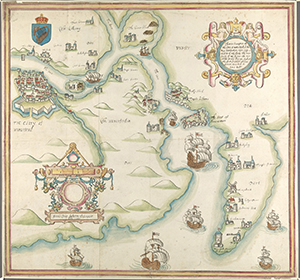Waterford, Henry II and Thomas à Becket
Published in Uncategorized
Waterford estuary was the arrival and departure point on many significant occasions in Irish history. It was here at Crooke, near Passage East, on St Bartholomew’s Eve, 23 August 1170, that Richard FitzGilbert de Clare, better known to us as Strongbow, arrived to initiate the Norman invasion. Later that same year something happened in the English county of Kent that is not normally seen as relevant to Irish history. On a bitterly cold 30 December, Thomas à Becket, archbishop of Canterbury, was brutally murdered in his own cathedral by three knights acting, so they assumed, on behalf of King Henry II, then ruler of England, Normandy, Brittany, Anjou, Aquitaine and much of Wales. Thomas had been the king’s closest friend but had infuriated Henry on becoming archbishop by, among other things, refusing to hand over to the crown for punishment churchmen accused of sexually assaulting and murdering subjects. When he became archbishop, Thomas was expected to abolish this canon law practice but he refused. According to tradition, a hot-headed and exasperated Henry had declaimed after perhaps too much wine, ‘Who will rid me of this troublesome priest?’ and the three loyal knights left France immediately for England.
Pope Alexander III demanded that the knights atone for this sacrilegious atrocity by making pilgrimage to Rome or Santiago de Compostela. Jerusalem was not an option, as it was then under Muslim control. In the following year, at the Council of Argentan in July, Henry was relieved of making a penitential crusade to the Holy Land until he had secured control of Ireland. Ireland had its own troublesome priests and Rome was anxious to bring them into line. Henry was in no hurry to return to London either. Pilgrims were already thronging to Canterbury in huge numbers, attracted by the miracles being attributed to Thomas the Martyr. Henry’s head was being called for and his crown was in peril.
On 17 October 1171 the bows of Henry’s 400 ships crunched up onto the safe sandy beaches at Crooke and Passage East. The ships are said to have carried 500 knights, 4,000 men-at-arms and archers, and thousands of horses. On the following day, the feast of St Luke, Henry II advanced on Waterford and set about bringing the Normans, the Irish and the remaining Norsemen into submission to the crown of England. Before leaving for Dublin he founded a church dedicated to St Thomas the Martyr outside the walls of Waterford. The church no longer exists but Thomas Hill still leads towards the site from O’Connell Street in the city centre.
In the following year, 1172, at Avranches, Henry was given absolution for his part in the murder of Thomas à Becket, but his penance was to provide for the maintenance of 200 Knights Templar in the Holy Land and to undertake a crusade, either to the Holy Land or to Compostela. Fearing that his avaricious sons (especially the future kings Richard and John) would usurp his crown while abroad and knowing that funding 200 knights would bankrupt the kingdom, Henry instead offered strategically important tracts of lands in Waterford to the Knights Templar, including control of the lucrative ferry rights between Passage East and Ballyhack in County Wexford. In return, they were to provide sanctuary and protection to travellers, especially pilgrims. The present Ballyhack Castle was built by the Knights Hospitaller around 1450 and is said to have replaced a much earlier Templar preceptory where pilgrims could have claimed shelter.
















